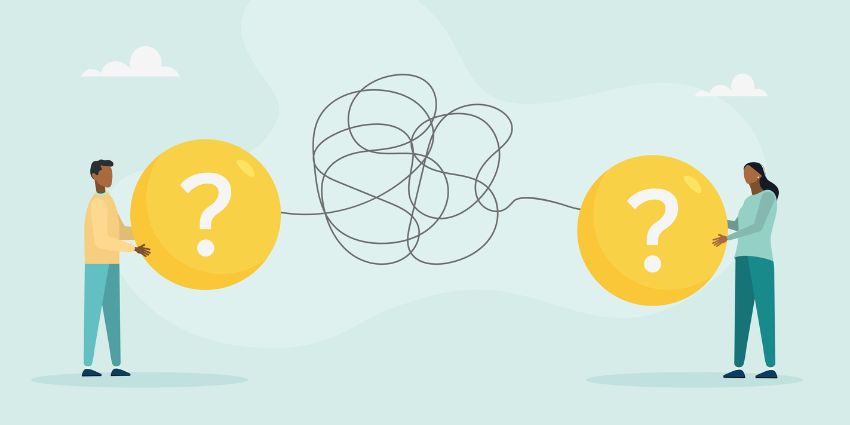Customers today are bombarded with automated responses, while what they truly seek is that rare, human touch. That is why advanced communication techniques matter in customer service more than ever before.
Here are 10 ways your agents and sales team can improve the quality of service, by simply transforming their communication style.
1. Active listening: More than just nodding along
We’ve all been guilty of it—listening just enough to respond but not truly understanding the other person’s point. Active listening goes beyond demonstrating agreement; it’s about fully immersing yourself in the customer’s words. When a customer feels heard, they feel valued.
Apply this by reflecting back on what you hear in your own words. When you master active listening, you’ll start catching subtle cues in tone and language that can reveal underlying issues. As a result, you can address concerns before they escalate into problems.
2. Empathy mapping: Stepping into the customer’s shoes
Imagine understanding not just what your customer is saying, but also what they’re feeling, thinking, and even fearing. That’s what empathy mapping achieves. This technique involves visualizing a customer’s experience by breaking down their thoughts, emotions, and concerns into a structured format.
Use it when you’re troubleshooting complex issues. By mapping out their emotional and cognitive state, you can tailor your responses to not just solve their problem but also reassure and comfort them. It’s a game-changer for high-stress situations where the emotional stakes are high.
3. Mirroring: The subtle art of building rapport
Have you ever noticed how you naturally sync with someone who shares your body language or tone? Mirroring is a psychological technique where you subtly mimic the customer’s gestures, language, or tone to create a sense of rapport.
When done correctly, the customer will feel more understood and connected, which opens the door for smoother communication and quicker resolutions.
4. Questioning techniques: Getting to the heart of the matter
Questions are powerful tools, but not all questions are created equal. Open-ended questions invite the customer to share more, while closed questions can help narrow down specifics. Use a combination of both to guide the conversation.
For instance, start with “Can you tell me more about the issue you’re facing?” and follow up with “Is it occurring during a specific time?” This technique not only clarifies the problem but also shows the customer that you’re invested in solving it. The more precise your questioning, the quicker you’ll uncover the root cause of any issue.
5. De-escalation techniques: Navigating heated conversations
There’s no denying that some customer interactions can get tense. When emotions run high, it’s essential to de-escalate the situation effectively. Techniques like maintaining a calm tone, validating the customer’s feelings, and offering immediate solutions can turn a potentially explosive conversation into a constructive one.
Timing is crucial here; the quicker you implement these techniques, the faster you can diffuse tension. The benefit? A satisfied customer who feels respected, even when things don’t go as planned.
6. Storytelling: Making your message memorable
Stories are powerful because they resonate on an emotional level. When explaining a solution or conveying a policy, turn your explanation into a narrative. For example, rather than just stating a policy, share a story of how it helped another customer in a similar situation.
This technique helps customers relate to the information, making it more memorable and easier to understand. Storytelling is especially effective in complex situations where you need the customer to see the bigger picture.
7. Non-verbal communication: The silent language of success
Words are just one part of communication; body language, facial expressions, and eye contact play equally critical roles when you’re in a video call, meeting, or trade show. Non-verbal cues can either reinforce your message or contradict it entirely.
Make sure your body language is open and inviting—lean in slightly when the customer speaks, maintain eye contact, and avoid crossing your arms. These small adjustments can significantly influence how your message is received. When your verbal and non-verbal communication are in sync, customers are more likely to trust and engage with you.
8. Positive framing: Turning problems into opportunities
How you phrase your message can drastically alter the customer’s perception. Instead of saying, “We can’t do that,” try “Here’s what we can do.” Positive framing involves presenting information in a way that highlights the benefits rather than the limitations.
This technique is particularly useful in situations where you have to deliver bad news. By focusing on what you can offer, rather than what you can’t, you maintain a positive interaction that leaves the customer feeling satisfied, even when the outcome isn’t ideal.
9. Chunking information: Breaking down complex concepts
Customers can easily get overwhelmed when presented with too much information at once. Chunking involves breaking down complex information into smaller, more manageable pieces. Use this technique when explaining technical details or guiding customers through a complicated process.
By segmenting information into bite-sized chunks, you make it easier for the customer to understand and retain the information. The clearer your explanation, the more confident the customer will feel in following your guidance.
10. Feedback loops: Ensuring continuous improvement
Communication is a two-way street. After resolving a customer’s issue, ask for their feedback. Did they understand your explanations? Was there anything unclear? Feedback loops not only help you improve your communication skills but also show the customer that you value their input.
Closing thoughts
Mastering these advanced techniques won’t happen overnight, but with consistent practice, you can transform how you interact with customers. So, next time you’re in the thick of a challenging conversation, remember: the difference between a good interaction and an exceptional one often lies in how well you communicate.
Did you find this article useful? Follow us on social media for more such insights.







